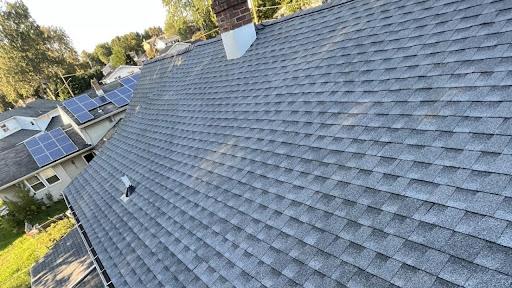Blogs

Why DIY Roof Repairs Can Be Risky: Trust the Professionals
DIY roof repairs may seem cost-effective, but they carry significant risks. Working at heights poses safety hazards, and improper tool handling can lead to injuries. Hidden costs, such as equipment rentals and medical bills, can outweigh initial savings, and DIY repairs may void roofing warranties. Lack of technical expertise can result in improper installations, causing further damage or leaks. Misdiagnosing issues can exacerbate problems, leading to more costly repairs. Trusting professionals ensures quality work, safety, and long-term value for your roof.
Working on a roof is dangerous and can lead to costly mistakes, which can compromise the structural integrity of your home and lead to further complications. At Northeast Exteriors, we understand the importance of a well-maintained roof, which is why we’re here to explain why DIY roof repairs are often a bad idea and why it's best to trust experienced professionals for your roofing needs.
Key Takeaways
DIY roof repairs can lead to serious safety risks, including falls and injury from tools.
Untrained individuals may cause further damage or misdiagnose roofing issues, resulting in higher long-term costs.
Professional roofing services save time, money, and provide high-quality, durable results.
DIY repairs may void warranties, leaving homeowners financially liable for future repairs.
Working with professionals ensures the correct installation of roofing materials, offering peace of mind and avoiding costly mistakes.
Why DIY Roof Repairs Are Risky
1. Safety Risks
Working on a roof is inherently dangerous. From heights to unstable surfaces, the risk of injury is significant. DIYers often underestimate these dangers, resulting in falls and accidents.
Height and Falls: Roofs can be steep and slippery, increasing the likelihood of serious falls.
Proper Safety Gear: Professional roofers are trained in safety protocols and use specialized equipment like harnesses and helmets.
Accident Prevention: Experts know how to navigate wet and steep roofs safely, reducing the chance of injury.
2. Injury from Tools
DIY roof repairs often involve power tools and heavy materials. Without the proper training, using these tools can lead to serious injuries.
Power Tools: Tools like drills and nail guns require skill to handle safely. DIYers may accidentally cause cuts or other injuries.
Heavy Materials: Moving large roofing materials without experience can result in strain or accidents.
Professional Expertise: Professional roofers are highly trained in handling tools safely, reducing the risk of injury.
3. Financial Implications
While DIY repairs may seem cost-effective, they can lead to hidden costs that outweigh the savings.
Initial Expenses: Costs for tools, equipment, and materials can add up quickly.
Additional Repairs: DIY work often results in the need for more expensive repairs if done incorrectly.
Warranties: Many roofing products require professional installation to maintain their warranties. DIY repairs can void these warranties, leading to costly repairs in the future.
4. Quality of Work
Repairing your roof isn’t just about fixing visible damage. It requires specialized knowledge to ensure the entire roofing system is intact.
Untrained Errors: Without the right expertise, you may make mistakes that lead to further damage, such as improper sealant application.
Professional Knowledge: Roofers understand various roofing materials and systems, ensuring proper repairs the first time.
Long-term Durability: Proper repairs can extend the life of your roof, while poor work can cause water leaks and structural issues.
5. Time Consumption
DIY projects often take longer than expected. Homeowners underestimate the time and effort required to repair or replace a roof.
Learning Curve: Without experience, what should be a simple task can take days or even weeks.
Efficiency: Professional roofers work efficiently and have the right tools to complete repairs quickly.
Stress-Free: Hiring a professional saves time, allowing you to focus on other tasks without the frustration of DIY delays.
6. Potential for Further Damage
Misdiagnosing the root cause of a roofing issue can lead to worsening problems down the road.
Superficial Fixes: A DIYer may only address visible problems, leaving underlying issues unchecked, such as damaged flashing or poor ventilation.
Expert Diagnosis: Professionals are trained to spot hidden problems and treat the root cause, preventing more damage.
Long-Term Savings: Fixing the problem properly the first time can save significant costs on future repairs.
How to Choose the Right Roofing Material for Your Home
Choosing the right roofing material is crucial for your home’s protection, aesthetics, and long-term value. Each material comes with its own set of advantages and drawbacks, so it’s important to choose one based on your home’s needs, location, and budget.
Asphalt Shingles: The most common and affordable option, asphalt shingles are easy to install and come in various styles and colors.
Metal Roofing: Known for its durability and energy efficiency, metal roofing can withstand harsh weather conditions and is long-lasting.
Wood Shingles: Offering a natural, rustic look, wood shingles are ideal for certain home styles but require more maintenance.
Slate Roofing: Extremely durable and long-lasting, slate provides a high-end appearance but comes with a higher cost.
Rubber Roofing: Best for flat roofs, rubber roofing is cost-effective, waterproof, and low-maintenance, though it may not be aesthetically appealing for all homes.
The Importance of Regular Roof Inspections
Regular roof inspections are essential for maintaining your roof’s integrity and preventing costly repairs. Identifying minor issues early can extend the life of your roof and save you from future expenses. Here’s why regular inspections are so important.
Early Problem Detection: Inspections help identify leaks, damaged shingles, or other issues before they become major problems.
Preserve Warranty: Some roofing warranties require regular professional inspections to remain valid.
Safety: Inspecting your roof ensures that no hazards, like loose tiles or sagging structures, are present.
Prevent Water Damage: Early detection of leaks can prevent water damage inside your home, saving on interior repairs.
Extending Roof Life: Regular maintenance and inspections can add years to the lifespan of your roof by addressing small issues before they escalate.
How Roof Maintenance Can Save You Money
Routine roof maintenance is key to protecting your home and investment. It can prevent costly repairs and keep your roof in top condition. Here’s how regular maintenance can save you money in the long run.
Prevents Costly Repairs: Addressing small issues early on can prevent expensive damage from developing.
Extends Roof Lifespan: Regular cleaning and inspections help extend the life of your roof, avoiding the need for early replacement.
Improves Energy Efficiency: Maintaining your roof can help keep your home energy-efficient, reducing heating and cooling costs.
Protects Home Interior: Proper roof maintenance prevents leaks, protecting your home’s interior from water damage.
Improves Curb Appeal: A well-maintained roof enhances the appearance of your home, which could increase property value.
Signs You Need a Roof Replacement
It’s not always easy to know when your roof needs replacing. By recognizing the early warning signs, you can make informed decisions about repairs versus a full replacement. Here are some key indicators that your roof may need replacing.
Leaks: Persistent leaks inside your home often signal a need for a full roof replacement.
Missing Shingles: If a significant number of shingles are missing or damaged, the roof may no longer be reliable.
Age of Roof: Roofs older than 20-25 years may need to be replaced, even if no visible issues are present.
Sagging: If your roof has visible sagging or dips, this could indicate structural damage requiring a replacement.
Extensive Moss or Algae Growth: Excessive moss or algae growth can lead to decay, signaling a need for replacement.
The Risks of Ignoring Roof Damage
Ignoring roof damage may seem like a cost-saving measure, but it can lead to much more serious problems over time. Delaying repairs can cause significant damage and increase the cost of future repairs. Here’s why you shouldn’t ignore roof damage.
Structural Damage: Water infiltration can compromise the structural integrity of your home.
Mold Growth: Moisture from roof leaks can lead to mold, which poses health risks and requires expensive remediation.
Water Intrusion: Unrepaired leaks can lead to water damage to insulation, ceilings, and walls, resulting in costly repairs.
Decreased Home Value: A damaged roof can decrease the overall value of your home, making it harder to sell.
Increased Repair Costs: The longer you wait, the more severe the damage will become, leading to higher repair bills.
Frequently Asked Questions About Roof Repair
How do I know if I need a roof repair or replacement?
If your roof is leaking, has missing shingles, or is over 20 years old, it may be time for a replacement. A professional inspection can determine the best course of action.
How long does a roof repair take?
Roof repairs typically take a few hours to a couple of days, depending on the extent of the damage. A professional team can complete the job more efficiently than DIYers.
What are the signs that I need a roof inspection?
If you notice leaks, damaged shingles, or signs of wear and tear, it’s time to schedule a roof inspection to assess the condition of your roof.
Contact Us for Expert Roofing Services in Palmyra, NJ
Looking for reliable roofing services? Contact us at Northeast Exteriors for professional roof repairs, replacements, and installations. Serving Palmyra, NJ, and the greater Philadelphia & South Jersey areas, we’re committed to delivering high-quality, durable solutions that protect your home. Let our experts handle your roofing needs safely and efficiently!
Hours
Monday: 8:00AM - 6:00PM
Tuesday: 8:00AM - 6:00PM
Wednesday: 8:00AM - 6:00PM
Thursday: 8:00AM - 6:00PM
Friday: 8:00AM - 6:00PM
Copyright © Northeast Exteriors 2025. All Rights Reserved. Privacy Policy. Terms & Conditions. Web Design by Fused Media





